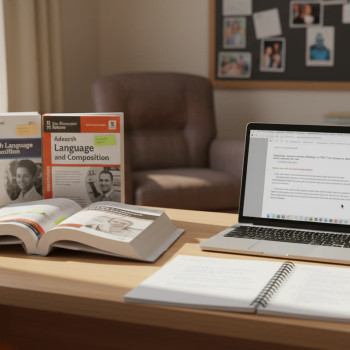Why Word Problems Matter (And Why You Can Master Them)
Word problems are where math meets life. For many AP students they are the checkpoint that separates procedural comfort from true conceptual understanding. They test reading, interpretation, model-building, and algebraic fluency all at once. But tackle them with a calm, systematic method — Translate → Setup → Solve — and suddenly they stop being monsters and become puzzles you can enjoy solving.

The Three-Step Framework: Translate → Setup → Solve
Think of each word problem as a short story about quantities and relationships. The three-step framework gives you a repeatable routine:
- Translate: Convert words into mathematical language — identify variables, units, and relationships.
- Setup: Build the equations, inequalities, or expressions that model the situation.
- Solve: Carry out the algebra, check units and reasonableness, and interpret the answer in context.
Below we’ll unpack every step, add habits that speed your thinking under time pressure, and practice with examples that mirror AP-style problems.
Step 1 — Translate: Become a Story Detective
Translation is about precise reading. Don’t skim — slow down for the first 60–90 seconds and annotate the problem. These are the signals to look for:
- Keywords for operations: “total”, “sum”, “difference”, “product”, “per”, “each”, “rate”, “increased by”, “decreased by”, “at least”, “no more than” — map these to +, −, ×, ÷, %, ≥, ≤ as appropriate.
- Quantities and units: Note whether you’re dealing with hours, miles, dollars, people, liters — mixing units is a common trap.
- Unknowns: Choose variables that feel natural. If the problem asks “how many apples”, use A or x_apples — clear names help when writing interpretation sentences later.
- Relationships: Pay attention to comparative language — “twice as many”, “3 less than”, “four times the speed of” — these translate into multiplication and subtraction patterns.
Practical tip: Circle or underline quantities and highlight verbs that indicate relationships. Doing this physically on the page reduces cognitive load when forming equations.
Step 2 — Setup: Build the Model
Once the translation is clear, write a short sentence that describes the relationship mathematically. For example, if the problem says “Claire has 3 more than twice the number of marbles Sam has,” write:
Let S = number of marbles Sam has. Then Claire = 2S + 3.
This short sentence is your anchor. From there, translate to an equation that directly answers the question (e.g., if total is given, set their sum equal to that total).
Some additional setup strategies:
- Use diagrams: For geometry or rate problems, sketching the scenario clarifies what to equate.
- Check domains: If a variable represents people or objects, enforce non-negativity or integer constraints when relevant.
- Reduce to simpler pieces: If the situation contains multiple stages (e.g., an initial amount, then a percent change), represent each stage as a separate equation or expression and link them.
Step 3 — Solve: Keep the Work Clean and Check
Algebra mechanics matter, but more often students lose points by making small translation or arithmetic mistakes. While solving, follow these habits:
- Write each algebra step clearly; don’t hide work behind leaps.
- If you use a calculator, copy intermediate results to avoid mis-entry under time pressure.
- After solving, perform a quick sanity check: plug the answer back into the setup sentence and verify units and sense (e.g., negative people or speeds should be rechecked).
- State the answer in a complete sentence if the prompt asks for interpretation — AP free-response questions value clear communication.
Worked Examples — Apply the Method
Practice is where the method clicks. Below are representative AP-style examples with detailed thought processes.
Example 1 — Linear Word Problem (Mixture of Quantities)
Problem: “A tutoring center charges $30 for the first hour and $20 for each additional hour. If a student paid $110, how many hours did they spend?”
Translate: Identify fees and unknowns. Let h = total hours. The cost = 30 for first hour + 20 for (h − 1) additional hours.
Setup: Cost equation: 30 + 20(h − 1) = 110.
Solve: 30 + 20h − 20 = 110 → 20h + 10 = 110 → 20h = 100 → h = 5.
Check: First hour 30 + 4 additional × 20 = 30 + 80 = 110. Interpretation: The student spent 5 hours.
Example 2 — Rate Problem (Distance = Rate × Time)
Problem: “A bicycle travels 8 mph faster than a runner. In 2 hours the bicycle travels 16 miles more than the runner. Find their speeds.”
Translate: Let r = runner’s speed (mph). Bicycle speed = r + 8. Distances: runner = r × 2, bicycle = (r + 8) × 2.
Setup: (r + 8)×2 − r×2 = 16.
Solve: 2r + 16 − 2r = 16 → 16 = 16, which is always true. This signals dependent equations or missing information — maybe the problem intended a different time for each traveler. When you get an identity, step back and re-read the problem. Perhaps the bicycle’s time differs, or the extra distance accumulates over a different interval. This is a great example of why translation and careful reading matter.
Common Traps and How to Avoid Them
AP exams reward precision. Here are traps students commonly fall into—plus how to avoid them.
- Misreading the question: Always underline the question sentence. It often specifies what to solve for or what to express, and you’ll sometimes find that your initial variable choice was off-target.
- Mixing units: Convert units early. If a speed is in km/h and time is in minutes, convert time to hours or speed to km/min before plugging into formulas.
- Overcomplicating: If algebra gets messy, check whether a simpler substitution or ratio would have worked. Often a smart substitution reduces algebraic noise.
- Ignoring domain constraints: If a problem implies integer answers (people, whole objects), keep that constraint in mind and call it out in your solution.
Study Habits That Turn Problems into Strengths
Building competence is a practice loop: attempt, reflect, and correct. Here are practical habits for steady improvement.
- Daily warm-up: Start each study session with 2–3 word problems of varying types. Keep them short and intentional — you want diverse practice more than repetition of the same style.
- Error log: Maintain a running notebook of errors. For each mistake, write the problem, your incorrect step, the right step, and a short note on why you erred. Reviewing this log weekly prevents repeat errors.
- Timed practice: Simulate exam conditions periodically. Time pressure reveals strategy flaws that untimed practice hides.
- Active explanation: Explain your solution out loud or to a study partner. Teaching forces clarity and uncovers shaky logic.
- One-on-one coaching: When you hit a persistent stumbling block — say, translating complex rate or work problems — personalized tutoring that targets your exact misunderstandings speeds progress. Sparkl’s personalized tutoring offers tailored study plans and expert tutors who can break down recurring mistakes into fixable habits.
Structured Practice Plan (8 Weeks Before the Exam)
Below is a practical 8-week schedule that blends targeted practice with review. Adjust the intensity to match how close you are to the exam date.
| Week | Focus | Weekly Goal |
|---|---|---|
| 1 | Foundations: translate basic language to math | 15 problems, error log started |
| 2 | Linear relationships and proportions | 10 timed problems + 10 untimed |
| 3 | Rate and work problems | Focus on diagrams, 12 problems |
| 4 | Geometry word problems (areas, volumes, angles) | 10 problems + sketch practice |
| 5 | Quadratic applications and systems | 12 mixed problems |
| 6 | Advanced multi-step word problems | 10 challenging problems, analyze step-by-step |
| 7 | Full timed sections and pacing | 2 timed sections, error analysis |
| 8 | Targeted review and calming strategies | Address remaining weaknesses |
Strategies for Different AP Math Formats
AP math assessments may include multiple-choice, free-response, or lab-based questions depending on the course (Calculus, Statistics, etc.). Tailor your approach to the format.
Multiple-Choice
- Quick translation and rough checks first — if you can eliminate two choices immediately, your odds improve greatly.
- Use estimation and dimensional analysis to discard unreasonable choices.
Free-Response
- Show clear reasoning: label variables, show the setup, and interpret the answer. Partial credit often rewards process even if arithmetic slips occur.
- Write an interpretation sentence — it proves you connected the math to the story.
Statistics-Focused Word Problems
For AP Statistics, word problems ask you to interpret data, choose appropriate models, and justify assumptions.
- Always state assumptions about distributions or independence when the prompt implies them.
- Sketch the data context: Is bias possible? Is the sample size sufficient? These short comments can be decisive in free-response sections.
Quick Reference: Translation Cheat Sheet
Keep this in your notebook for fast translation during practice and the exam.
| Words | Mathematical Mapping | Example |
|---|---|---|
| Twice as many | 2 × variable | “Twice as many cats as dogs” → C = 2D |
| More than | + | “3 more than” → x + 3 |
| Per | / or rate | “Miles per hour” → distance / time |
| Of | Multiplication | “50% of 80” → 0.5 × 80 |
How to Use Technology Wisely
Calculators and symbolic tools can speed arithmetic and graphing, but they can’t replace careful translation. Use technology for:
- Checking arithmetic after you’ve set up an equation.
- Graphing relationships to visualize intersections or solutions.
- Running statistical calculations once you’ve correctly identified the model.
Don’t use technology as a crutch. If you rely on it without logical checks, you’ll be vulnerable to syntax errors or mis-specification. A good middle ground is to do a quick mental or by-hand sanity check, then use the device to confirm details.
Mindset and Test-Day Calm
Performance depends not only on knowledge but on composure. On test day, use these small rituals:
- Do a 2-minute breathing exercise before you open the booklet.
- Scan the section to identify straightforward problems to build confidence and momentum.
- Mark harder problems and return to them with fresh focus; don’t dwell early on something that’s blocking you.
- When stuck, restate the problem in one sentence — clarifying often reveals the missing translation.
Working with a tutor in the weeks before the exam can help you practice these test-day routines. Tutors can run timed mocks, give focused feedback on translation habits, and build confidence through repetition. Sparkl’s personalized tutoring emphasizes smart pacing and tailored study plans so you practice the things that actually move your score.
Final Thoughts: From Confusion to Clarity
Word problems are a skill, not a talent. The Translate → Setup → Solve framework gives you a reliable roadmap that you can apply to any problem type. With steady practice, an error log, timed simulations, and occasional guided support (like one-on-one tutoring when you need it), you’ll turn anxiety into strategy.
Remember: the key is not to memorize tricks but to strengthen the chain of reasoning — precise reading, faithful modeling, and careful solving. Each time you practice a problem with this discipline, you’re not only preparing for the AP exam — you’re building the kind of mathematical thinking that lasts well beyond a single test.
Parting Checklist
- Translate carefully: underline quantities and relationships.
- Set up clear equations or models; write an anchor sentence that summarizes the relationship.
- Solve cleanly, check units, and interpret the answer in context.
- Keep an error log and practice a variety of problem types.
- Use technology to check, not to replace, logical work.
- Consider targeted, personalized tutoring if you want accelerated progress — it can fix recurring mistakes faster than solo study.
Good luck — with a steady routine and thoughtful practice, translating word problems becomes second nature. Approach each problem like a story, and you’ll find the math hiding in plain sight.

















No Comments
Leave a comment Cancel